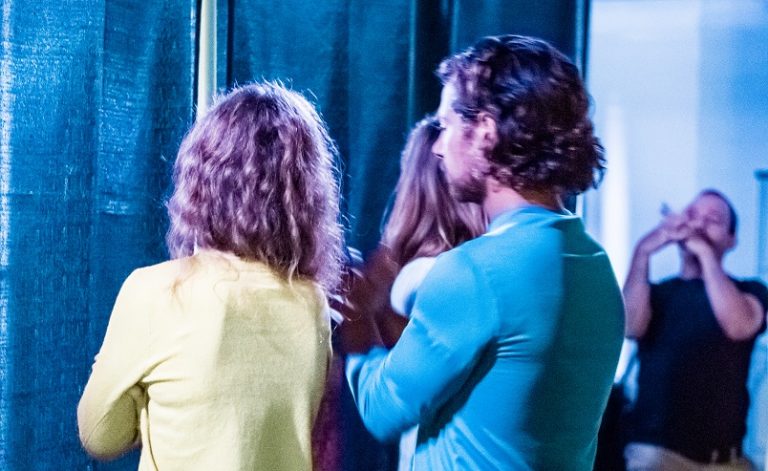The speed of human technological innovation is to me, unfathomable. It is a world unto itself. This state of affairs is thanks to, in no small part, the human imagination; our capacity to connect and learn from one another and conceive some ultimate supercomputer which, in theory, will surpass all human ability. Advancements in the tech sector lunge us closer and closer to artificial intelligence which may one day be capable of human-like thought.
These computers, like ourselves, will become entire worlds unto themselves. Ironically, as we make our way down the information super-highway toward more human-like AI, we are increasingly attached to interactive screens and devices which, one could argue, make us less human. Apparatus which unlock to your fingerprint, your face, your voice, correct your typos and read your body language; all of this technology is called “interactive.” These are interactions between human and machine.
There is another way to think if the word interactive. On the other side of the coin are our interactions with other people; between human and human. One of the largest forums for such interaction is live performance. In the world of live performance, Improv is exploding worldwide thanks to books such as “Impro” by Keith Johnstone, and “Truth in Comedy” by Charna Helpern & Del Close, as well as groups like IO, UCB and the TV show “Whose Line Is It Anyway?”. Today, improvised theater has a presence in every major city in the US and most major cities in Latin America, Europe and beyond. Since the early 90’s the popularization of this form of impromptu storytelling has been steadily increasing. In ’14 the Barcelona Improv Group launched Spain’s first international English Improv festival. By 2017 it was Europe’s largest improv festival, with 200 improvisors representing 22 countries performing to an audience of around 700 people. On Broadway, shows which incorporate improv and immersive elements such as “Tony and Tina’s Wedding”, The Barrow Street Theater’s “Sweeney Todd: The Demon Barber of Fleet Street”, “Sleep No More”, and Live in Theater Production’s numerous show-offers are all testament to the growing popularity of improvised, semi-improvised and immersive story experiences.
In a world where the tech industry is growing and advancing at an exponential rate, and where live theater is arguably in decline or, at least directly in competition with these technological advances, what is it that has caused this growth in live entertainment? There is something that keeps improv audiences coming back. Something that keeps the experience on the tip of their tongues as they proselytize this spontaneous, co-created story experience to their peers. Many audience members will even take the bold step of signing up for improv classes so that they can try their hand at this increasingly prevalent community storytelling. Those last two words are likely the cause of this fascination with Improv; “community storytelling”.
The very thing that those digital ‘interactive screens’ cannot offer us as audience members, at least at the moment, is a sense of living a story together, in symphony. In the audiovisual realm, cinema, t.v., streaming, etc. are finished products; sculptures frozen in time which can’t change. In classic theater, this is true to a lesser degree. The audience, after all, is partaking in a show that technically will never be perfectly duplicated. In improvised theater there is no doubt; this is a story experience which is exclusive to this night, this moment, and these people in the room. No one knows what story will be told and everyone knows that this story will never be told again. The audiences reactions, their laughter, shrieks, silence- in some instances, audiences will even offer suggestions to the actors; these variables will very much guide the trained improviser in their spinning of the story threads.
There’s no doubt that we are social creatures, we live to connect. And there’s nothing that compares to connecting with a theater full of people during a communal creation and discovery of a plot twist, a character’s fall from grace, or their eventual triumph. The star on the stage is discovering this very moment with you, the audience. Few mediums offer audiences and players such a connection to instantaneous co-created storytelling. Studies have found that the heartbeats of audiences experiencing riveting story become synced, that brain-patterns of people experiencing stories become identical.
There is another medium which invites audiences to participate in the telling of story to an even larger degree. A medium wherein the spectators can do more than laugh or gasp, applause or remain silent to affect the story’s fate. It’s called “interactive” theater.
I’ve been involved in numerous stagings of this interactive theater. These have been initiatives of my own and most recently thanks to a nine-month think tank in which I’ve joined 9 other performers called the “Interactive Deep Dive”. The results for our spect-actors (whom we call “spects”) has been consistent and potent.
There are two basic types of interactive experiences. The first is “blue sky narrative”, meaning that nothing is prepared. The story emerges thanks to the training of the 4 to 7 interactors in story creation and decisions made by a non-performer as the protagonist. The spect is a willing participant. They can be any person from any profession with any experience. We’ve done this ‘blue sky’ experience with dramaturges, dancers, writers, computer programmers, entrepreneurs, producers, traditionally abled and alter-abled, old and young. We explain that we’re about to co-create a story with them. We tell our spect they can do no wrong, then away we go. For those familiar with the Improvisers TJ & Dave, the story begins in a similar way. There is no suggestion, no bearing on anything conscious. The spect steps “into” the story and literally anything can happen. The next period of time, normally around 15 minutes, is driven principally by the spect’s choices and their body language. The spect is in the spotlight for the duration of the story and when it’s done and the lights go down a story has been performed with our spect in the leading role.
The second type of interactive experience is scripted. Naturally, our spect in this experience will not know any lines. We supply them with the necessary information to jump-start their experience; who they are and what world they’ll inhabit for the duration of the experience. These experiences can last for a few minutes, or several days.
I’ve learned a lot from creating interactive theater. You don’t have a script. You don’t get to plan. You just have to find your own experiences, your own emotions, and create something awesome. At its core, this interactive art doesn’t depend on you reading about it. It depends on you continuing to hunger for real human connection. The kind of connection the value of which is truly invaluable. Every individual is a world unto themselves, and when people come together for the sake of creativity, new worlds are built and the results are unfathomable.





